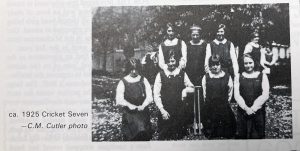If you’re an England football fan, I’m sure you’ve been cheered by the start England have made in the Euros and are eagerly looking forward to the Scotland game. If you’re a cricket fan, you might not be feeling so buoyant, given England’s recent defeat in the series against New Zealand. However, there is still women’s cricket to enjoy, in the shape of the Rachael Heyhoe Flint Trophy, named after the woman who did most to raise the profile of the women’s game in the last decades of the 20th century, storming the male bastion that was Lord’s and establishing a women’s World Cup before the men did the same.

What of girls’ cricket at OLA? This is a question I’m frequently asked by prospective pupils, which has led to a review by our PE department of girls’ sport provision. More on this soon. This has prompted me to do some digging into old copies of OLA’s school magazine, ‘The Annual’, editions of which we have dating from 1927 to the 1960s. The results are fascinating. Unlike football and rugby, cricket appears to have been well-established as a girls’ sport from an early date. Sr Penny Roker’s history of OLA, ‘Children of Mercy’, records several instances of the girls playing cricket in the school, including a match against the boys of the prep school in 1926. The result was not in dispute, but while the girls’ diary records imperiously: ‘Cricket match with the boys. Result obvious’, the boys comment tersely: ‘Naturally, we had to let them win’. Cricket was just as popular as tennis as a summer sport, with Sr Penny noting: ‘The girls preferred to play cricket regularly all summer, although it was really meant to be for the junior girls’.
My researches in the Annual reveal that, while tennis, hockey and netball generally ruled the roost as they continue to do today, cricket undoubtedly had its adherents. Each of the magazines has a ‘Games Report’, detailing the kind of triumphs that would now receive lavish treatment in the newsletter and on the website, with occasional photographs of girls holding sticks and rackets. Sadly, I haven’t been able to find any pictures of girls at the wicket. The fullest entries for the summer game are to be found in the 1927, 1943 and 1944 issues. The first of these has a breathless account by one Sheila O’Sullivan which begins: ‘Cricket is my favourite game and, when it is a question of a match, I simply put my heart and soul into it.’ The writer makes reference to there being a ‘Convent Cricket League’ with the girls’ team being captained, in a way that would raise eyebrows today, by the ‘father of an old girl’.
To make up for a regular fixture being cancelled, the girls arrange a repeat of the 1926 match against the boys of the preparatory school. Unfortunately, the boys manage to overhaul our heroines’ total at the conclusion of what sounds like a thrilling, two innings contest. The chronicler records nobly: ‘It was a terrible moment; we did not like being beaten, but we bore it in the fine spirit of sportsmanship.’ The girls cheer up immediately when their captain presents them with ‘several large boxes with sweets’ which they promptly share with the boys.
According to the 1943 Annual, ‘the school has taken its introduction to cricket very well’, the writer clearly being unaware of what went on in the twenties. A year later the girls manage four school fixtures and three house matches, with cricket receiving a longer report than any other sport. Each member of the team is profiled, including a no-holds-barred assessment of form that would hold its own in any newspaper sports supplement today. P. Woolliams, for instance, is described as a ‘hard hitter who has probably been the most prolific scorer in the team. Her slow bowling too is quite tricky, but she must concentrate more on length.’ Take note, P. Woolliams.
Curiously, there is no reference to cricket at all from 1945, the departure of one Mrs Kirtin mentioned the year before perhaps meaning that there was no member of staff to carry on the tradition. A rumour has, however, reached me that girls’ cricket underwent a brief revival at OLA in more recent times, perhaps even run by two current members of staff. I will now be pursuing my researches in this direction.

